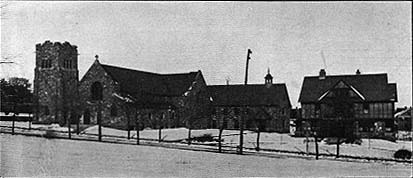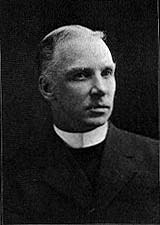|
History of Holyoke's Churches
St. Paul's Episcopal Church
Rev. Franklin Knight, Pastor
In December, 1849, an Episcopal parish was established in the section now known as Holyoke, and the name chosen was Trinity Church. Services were held regularly for about four months, Rev. Henry W. Adams being rector, but he resigned in April, 1850, and the project of an Episcopal church was soon abandoned. Those were not easy days for church enterprises here, for there were only 3,000 inhabitants, and the difficulties met by many of our churches in their early days are graphically illustrated by an item in the history of the early Episcopalian enterprise which died almost as soon as it was born. The item is as follows: "Owe no man anything." Romans 13:8. There being demands against the parish for about $100, for fuel, rent of organ, making fires, care of rooms, etc., and no funds in the treasury, the treasurer paid the same from his purse, and so saved the credit of the parish. 
St. Paul's Episcopal Church,
Parish House and Rectory No further effort was made to establish an Episcopal church here until 1863, when on Sunday, August 30, at the request of a resident of Holyoke, two out-of-town clergymen held divine worship in Exchange Hall. A church was organized October 12th the same year, with the following officers: Wardens, William Hancock and Donald Mackintosh; vestrymen, S.S. Chase, J.B. Orcutt, John E. Chase, T.B. Flanders, George A. Ward, M.D., William Grover, and J.S. Davis. The last-named gentleman gave the church free use of a very neat little chapel and parsonage on Maple street and they made use of this hospitality for two years. This church was built in a little more than two months' time. Friends in Hartford, Springfield, and in Emmanuel church, Boston, donated ecclesiastical furnishings, and Dr. Ward, in addition to his other helpful acts, gave a communion service. Rev. Joseph Kidder was rector, serving in 1863-1864. The first baptism recorded in the parish register took place on Whit Sunday, May 15, 1864; and on the occasion of the first visitation of the bishop, May 25, of that year one person was confirmed. It is worth noting that on the death of President Lincoln, the rector of this parish, Rev. O.H. Dutton, 1864-1865, was selected from among the clergy of Holyoke to preach the memorial sermon. Soon a movement for a church building was under way, but instead of this movement proving immediately successful a period of discouragement followed, and for a time worship was held in the hall of the engine house on High street, and then in a room owned by the Lyman Mills. After Rev. W.A. Holbrook, 1866-1867, and Rev. Edward W. Peet, D.D., 1867-1871, respectively, took the helm prospects again began to brighten, with the result that on the 9th of February, 1868, a new church building, located at the southeast corner of Maple and Suffolk streets, and built of carefully dressed stone, was occupied for the first time, Bishop Lee of Iowa, preaching the sermon. When Dr. Peet, lovingly called "dear old Dr. Peet," left the church he had freed it of debt, and although he was 65 years old when he began his work here, he not only piloted the church through the shoals but he left behind him an unusually deep affection. In the early seventies there was an era of financial prosperity, the most notable betterment being a $3,000 organ given by Mr. Mackintosh. A beautiful rectory was completed in 1882, and in 1887 the church was enlarged, by the construction of a gallery across the north end of the church. 
Rev. Franklin Knight
At the Easter meeting in 1888 it was decided to commence a permanent building fund for the erection of a new church, and this movement had its fruition and certainly it was a hundredfold fruition when, in October, 1905, the new church on upper Appleton street was dedicated. We must not, however, get so far ahead of our story. Following the rectorship of Dr. Peet came that of Rev. John Leech, who served for six months in 1872. Concerning him it is said that he was one of the most brilliant of all the preachers that have occupied the pulpit at St. Paul's. Then came Rev. Charles H. Lester, 1873-1876, during whose very efficient term, the list of communicants increased from 80 to 160. Rev. W.P. Tucker, 1876-1877, was in term succeeded by Rev. Amos Skeele, 1877-1881; then followed Rev. H.L. Foote, 1881-1889, who left among other marks of his activity, a fine record and a communicant list numbering at the end of his term of service 280. During the rectorship of Rev. J.C. Wellwood, 1889-1897, the present lot was bought, and the location is certainly an ideal one, on the north side of Appleton street, between Linden and Locust streets. Rev. George S. Sinclair was the rector from 1987 until 1899. It was not until the rectorship of Rev. H.H. Morrill, 1900-1911, that the present St. Paul's church, parish house and rectory, were actually built. Mr. Morrill served the church for a longer period than any of the other rectors. The whole city is proud of this beautiful property, churchly in its every appearance. The church contains several memorials; among which stand out conspicuously a beautiful east window, the gift of the children of Mr. Donald Mackintosh, who was identified with the life of the parish from the beginning until the time of his death in 1902, and was sometime warden; also an alter and reredos, the gift of Mr. Addison L. Green. The present rector, Rev. Franklin Knight, assumed charge of the parish September 1, 1911. He soon discovered its large potentialities, and looks forward to an ever growing and inspiring work. Mr. Knight is already esteemed as one of the most spiritual and lovable pastors, known to the present generation of Holyoke people, but he is also a strong supporter of civic righteousness, not fearing the pell mell of men. The church itself, which seats 500, is large enough for the present, but already the parish house is sadly inadequate, and must soon be extended. St. Paul's Church ministers to at least 1,000 souls; has a communicant list of 450, and in its Sunday school as an enrollment of 160. The parish is thoroughly organized and the societies are all very much alive. The members of the vestry are as follows: Senior warden, Charles E. Mackintosh; junior warden, Jason T. Draper; vestrymen, Fred F. Bennett, Howard Conant, Addison L. Green, James E. Jagger, John Smethurst, Day Chadwick, George P. Rice; clerk, William C. Gates; treasurer, John S. Clarke, Jr. The clerk, Mr. Gates, has become a veteran in the service, having faithfully executed the duties of his office from April, 1886, until the present time. During the years 1,030 baptisms have been registered; 630 persons have received the rite of confirmation; 500 marriages have been solemnized, and the burial service has been read 625 times. To turn to the financial side for a single moment it ought to be added that the total value of all the church property is rated at $76,000.
| People & Organizations | Allyn's Sketch of Holyoke |
| Selected Advertisments | Churches | Surname Index |
© Laurel O'Donnell 1996 - 2005, all rights reserved
This document may be downloaded for personal non-commercial use only and should not be reproduced or distributed without permission. |